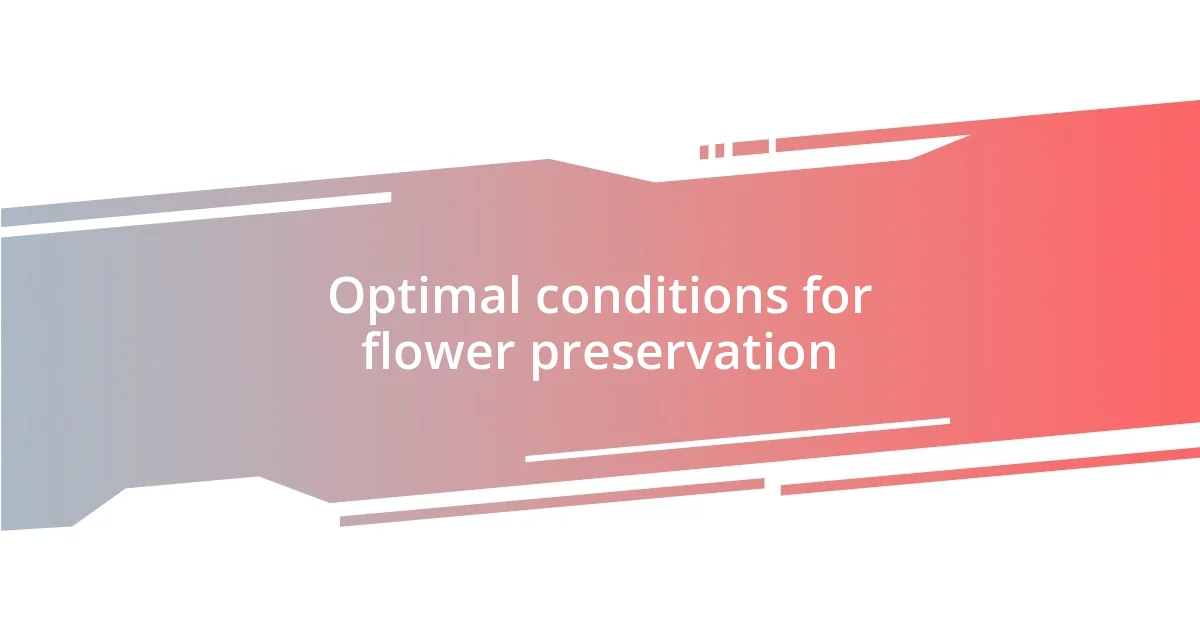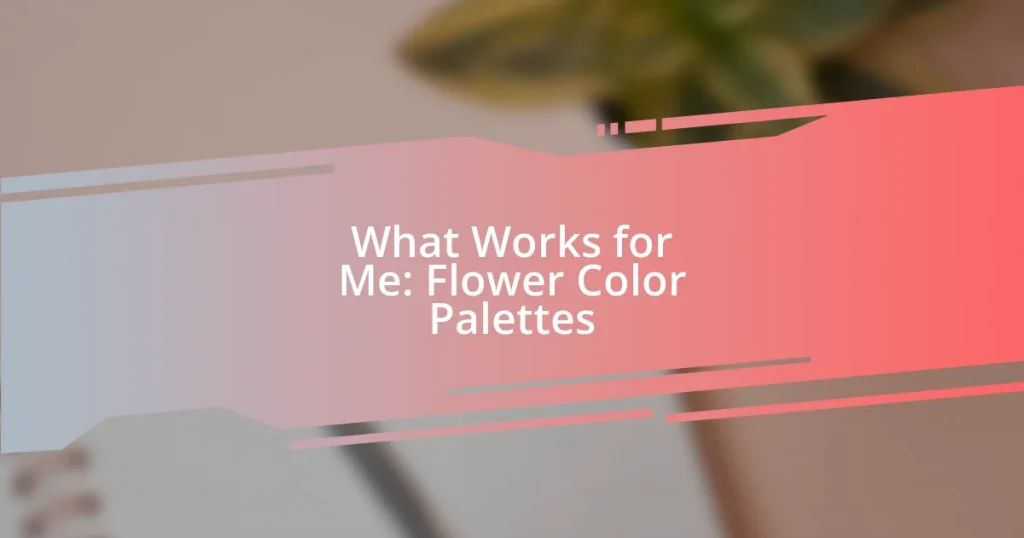Key takeaways:
- Water quality, temperature, and cleanliness significantly impact flower longevity; using filtered water, keeping flowers cool, and maintaining clean vases are essential.
- Avoid common mistakes like overcrowding vases, neglecting stem trimming, and ignoring decaying flowers to prevent premature wilting.
- Seasonal care is crucial; adjust flower care techniques based on environmental conditions, such as humidity and temperature, to maximize freshness.

Understanding flower longevity factors
When I first started exploring flower longevity, I was surprised to learn how the water quality plays a significant role. I remember cutting stems of roses and thinking that ordinary tap water was just fine, but soon discovered that minerals and chemicals can shorten a flower’s life. It’s fascinating how something as simple as using filtered water can make such a difference; have you ever noticed how fresh flowers tend to last longer in clearer water?
Temperature is another key factor that I noticed during my experiments with flower arrangements. I had a bouquet that began wilting way too soon, and I realized it was sitting in a warm, sunny spot, receiving all that direct light. This taught me that keeping flowers cool and shaded can really help maintain their beauty. Have you ever moved a vase to a cooler spot and found a noticeable difference the next day?
Finally, I’ve come to appreciate the impact of flower food. Initially, I thought it was just a gimmick, but after trying it out, the results were undeniable. Flowers treated with proper food not only survived longer but also bloomed more vibrantly. It’s like giving them a little extra love – don’t you think these small acts can transform an ordinary bouquet into an extraordinary display?

Optimal conditions for flower preservation
When I experimented with different environments for flower preservation, I quickly learned that humidity plays a crucial role too. I once kept a bouquet in a bathroom, thinking the humidity would be beneficial. To my surprise, while it indeed stayed lush for a bit longer, the high moisture drew out unwanted mold. I realized that a balanced humidity level—not too dry or too damp—is essential for keeping those blooms fresh without inviting trouble.
Along my journey, I discovered that the type of vase or container can also influence longevity. I remember purchasing a set of stunning glass jars and placing some flowers inside. However, I found that narrow-necked vases restricted air circulation, causing my arrangement to wilt prematurely. Now, I prefer wide-mouthed vases that allow for better water and air distribution, creating an ideal atmosphere for my blossoms. Doesn’t it make sense that the right container can enhance their freshness?
Another vital aspect is the cleanliness of the vase. In one instance, I didn’t properly wash a vase before using it, and I was shocked to see how quickly the water turned cloudy. Clear water is essential for flower longevity, just like a clean slate for our own wellbeing. I’ve learned that taking the time to rinse out vases not only looks better but actively contributes to extending the life of my floral arrangements.
| Optimal Condition | Impact on Longevity |
|---|---|
| Water Quality | Minerals and chemicals can shorten flower life; use filtered water. |
| Temperature | Cool temperatures preserve blooms; avoid direct sunlight. |
| Humidity | Balanced humidity prevents mold and preserves vitality. |
| Vase Type | Wide-mouthed vases allow for better air and water circulation. |
| Cleanliness | Clean vases keep water clear and blossoms healthy. |

Common mistakes that reduce longevity
I’ve stumbled upon several common mistakes that can really cut down a flower’s lifespan. For example, I once made the error of placing a beautiful bouquet next to a fruit bowl. I didn’t realize that fruits emit ethylene gas, which hastens wilting. It was disheartening to watch those gorgeous blooms droop before my eyes, a reminder of how little things can have a big impact.
Here are some other common pitfalls that can reduce flower longevity:
- Overcrowding the vase: I learned the hard way that too many flowers can prevent proper water absorption and airflow. Giving each stem space allows them to thrive.
- Skipping the stem trimming: I used to think trimming wasn’t necessary until I noticed how quickly flowers faded. Cutting the stems at an angle helps them drink water better.
- Ignoring decay: One time, I overlooked a few wilting flowers in the mix, and it quickly turned the whole bouquet sad and brown. Regularly removing dead blooms not only improves aesthetic appeal but also helps other flowers last longer.

Seasonal considerations for flower care
When the seasons change, so do the needs of our flowers. Winter can be particularly challenging, as indoor heating often dries out the air. I remember a time when I brought home a winter bouquet, but the dry indoor environment caused the petals to crisp up quickly. A simple solution? I started to group my flowers together, creating a microclimate that seemed to help retain some moisture. Have you ever noticed how flowers thrive when they’re snug together?
Spring is a time of rebirth and vigor, making it a perfect season for floral arrangements. As I embraced this period, I learned that blossoms seem to bloom brighter and last longer when placed in cooler areas away from direct sunlight. I once left a colorful bouquet on my windowsill, only to find it wilting within days. It’s fascinating how light influences their vitality, isn’t it? Now, I opt for more shaded spots that keep my flowers vibrant and fresh.
Summer brings its own set of challenges, particularly with higher temperatures. I had a stunning arrangement that I proudly displayed for a party, but as the day heated up, I saw the blooms drooping before my eyes. I’ve become diligent about checking the water level every day during these sweltering months. Have you found that adding ice cubes to the water can help combat the heat? I think it’s a refreshing trick that can be a game changer, prolonging the life of my summer bouquets.

Tips for maximizing freshness indoors
One crucial tip I’ve discovered for maximizing flower freshness is to always start with clean vases. I can’t stress enough how a dirty vase can sap the life from your blooms. After a particularly disheartening experience with a charming bouquet that wilted way too soon, I made it a rule to wash the vase with warm soapy water and rinse it thoroughly before arranging my flowers. It’s incredible how a little cleanliness can make a significant difference.
Temperature control is another area I’ve learned to be mindful of. A few summers ago, I had a gorgeous display of sunflowers that I placed on my kitchen counter, thinking they could brighten up my space. However, the heat from the nearby stove turned them into a sad memory within days. Now, I pay attention to where I place my flowers, keeping them in cooler spots away from heat sources. Have you noticed how flowers perk up when they’re in comfortable surroundings?
Lastly, I find it beneficial to refresh the water often—at least every couple of days. When I first started arranging flowers, I thought topping off the water was enough. But after witnessing a bouquet lose its vitality due to stagnant water, I realized how important it is to change it out completely. Adding flower food to the fresh water can also be a simple yet effective way to boost their longevity. It’s like giving my blossoms a little energy drink! What strategies have you discovered to keep your flowers lively?















